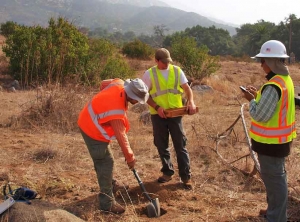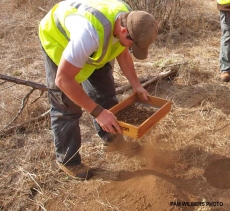
ECM Special Report
By Miriam Raftery
Photos by Pam Wilmers, Video by Billy Ortiz
Updated October 21, 2011
October 20, 2011 (Lakeside) – Construction of an access road needed for completion of the Sunrise Powerlink in Lakeside’s El Monte Valley has been halted due to discovery of a “possible Indian site” found during road-grading activities, a property owner informed ECM yesterday.
The property owner, whose name is being withheld due to a law prohibiting disclosure of the precise location of possible artifacts, said that a Powerlink project representative told her that a possible “Indian site” had been found while grading a road on an easement across her property.
The owner called an ECM freelance photographer and asked that ECM document the find with photos and videos. Upon arrival, photographers Pam Wilmers and Billy Ortiz were ordered to stay back 150 feet and was not allowed access to document what was found in materials being sifted. However Terry Francke, general counsel for Californians Aware (CALAWARE) has advised ECM’s editor that “anyone can go up to the edge of that easement.”
According to the property owner, who said she consulted her attorney, the easement is only 25 feet.
 Fritts Golden at Aspen Environmental, consultant on the Powerlink, confirmed in an email that “in preparation for access road construction, some resources were just identified adjacent to the road areas. An archaeologist is on-site conducting additional survey and assessment work,” he said, adding that work was being done in accordance with mitigation measures required for unanticipated discoveries and that “full cultural surveys of the site could not occur until just recently” because permission from the property owner was not forthcoming.
Fritts Golden at Aspen Environmental, consultant on the Powerlink, confirmed in an email that “in preparation for access road construction, some resources were just identified adjacent to the road areas. An archaeologist is on-site conducting additional survey and assessment work,” he said, adding that work was being done in accordance with mitigation measures required for unanticipated discoveries and that “full cultural surveys of the site could not occur until just recently” because permission from the property owner was not forthcoming.
The property owner, however, flatly denied Golden's statement. "That's not true at all," she told ECM on October 21. "We can't deny them permission because they took our site by eminent domain. From what I can see, they did very little digging at the site. I don't think they want to know what's in their right-of-way." She cited a Journal of San Diego History article which indicates the entire area was once a tribal village. "I would suggest they do a complete cultural resources assessment of the whole site."
At the site yesterday, Ortiz sought comment from several workers on site. All refused to comment on the finds. While a Native American observer was present, no archaeologist was on the scene while Ortiz was videotaping. View his video: http://www.youtube.com/watch?v=mM0pci1kLa0
The site is close to another recent archaeological find, also in Lakeside, where a Native American burial and ceremonial site rich with historically significant artifacts shut down a Padre Dam Municipal Water District project and prompted litigation with the Viejas tribe, which was later settled.
SDG&E spokesperson Jennifer Ramp has said that the California Public Utilities Commission and Bureau of Land Management have been notified of the “small cultural resource site.” She said that two archaeologists and a Native American representative were involved in work at the site Tuesday and Wednesday. After the review is completed, a report will be sent to the CPUC and BLM. No construction can occur at the site pending approval from both agencies, however construction continues on the rest of the project, Ramp said.
ECM has asked for SDG&E to respect easement rights for our photographer to move closer (fences prevent easy access) and has also asked for a photographer to be escorted onto the site to observe the dig close at hand and document what is found for the public record.
SDG&E, however, has denied the request thus far. “Due to the confidential nature of cultural artifacts locations, SDG&E is not allowing members of the media or the public to enter the site to take pictures and publicize the location of the resources,” Golden wrote in an e-mail, citing fear of looting. He added that SDG&E is coordinating with “the appropriate agencies.”
Ramp confirmed that position in an email to 10 News, forwarded to ECM. She cited “concerns expressed by members of the Native American community” as well as the “confidential nature of cultural resource location.”
ECM has assured Golden and SDG&E representatives in writing that the exact location would not be disclosed in any articles published.
Moreover, the prospect of looting appears remote or impossible. Prior to the discovery, SDG&E had already paid to have a California Highway Patrol guard access to the only road into the area, asking identification and writing down license plates of all who enter. According to two freelance photographers who have visited the site, to access it without going on the roadway would require climbing over four fences and a gate, across private property where there are numerous large, barking dogs.
Concerns over SDG&E’s handling of artifacts and Native American remains arose after an employee close to the Powerlink project spoke to ECM about artifacts found elsewhere along the high-voltage line construction path in East County.
“This project will impact sites that are very significant to our ceremonies. They are putting towers on them and it appears that we will not be able to go to those sites in the future,” he said during a Powerlink protest last year.








Recent comments